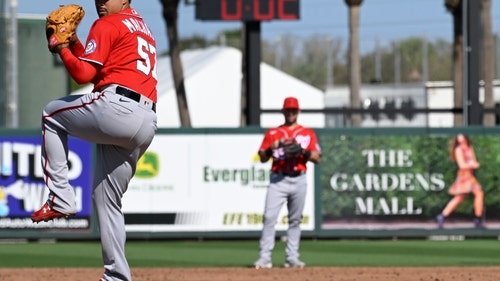
Meet the best-run team in sports
With the postseason finally, and mercifully upon us, I give you the best-run and least appreciated franchise.
Not in baseball.
In all of sports.
I give you the Tampa Bay Rays.
The way they whack up TV revenues, NFL owners have long enjoyed a form of rich man’s socialism. The NBA has its salary cap, of course. But the disparity between rich and poor in major league baseball remains a patent absurdity.
Yes, small market teams have won division titles before. In fact, it happens every year. This October’s qualifiers include Minnesota (though it’s difficult to argue that a $98 million team is small market) and Cincinnati. Then there’s Texas, which not only survived, but prospered despite the epic mistakes of a regime that left it facing bankruptcy.
But the best of those teams -- the Twins -- won 94 games. That’s third-place in the American League East. What’s more, the Rays win without a budget (much of one, anyway) or a fan base (at least as judged by the attendance figures). Still, they have managed to win the best and most expensive division in baseball two of the last three years.
“In the last 15 years, the Red Sox have won it once,” said Stuart Sternberg, who became the Rays' principal owner prior to the 2006 season. “Whatever happens with the World Series, that’s what I’m proud of. We’re not a wild-card team. To win the division is like winning the Belmont, the long race. It’s the real accomplishment…
“Take the Cardinals’ team that won the World Series. No disrespect to them, but they had (83) wins. They couldn’t dream of being in the playoffs in this division.”
The Cardinals, for the record, had an $89 million payroll on Opening Day that year, 2006. The Rays went into this season splurging at $72 million. And again, the Cardinals play in a division with one other legitimate big-market team, the perennially underachieving Cubs.
“In the last three years,” says Sternberg, “The Yankees and the Red Sox have spent $1.1 billion on players.”
In that same period, the Rays spent $179 million.
It’s worth mentioning that Sternberg -- like Matthew Silverman, his team president -- came to baseball fresh from a stint at the real Evil Empire, Goldman Sachs. But along with Andrew Friedman, the VP of baseball operations, they may be the only good thing to come out of Wall Street in recent memory. They’re literally giving it away.
After two home-grown stars, Evan Longoria and David Price, complained about attendance at Tropicana Field, the Rays gave away 20,000 seats to their final home game. They drew 18,482 more than they had the previous night.
“It’s bad down here,” said Sternberg, speaking of the local economy. “But people are still going to the movies, eight to 12 bucks a pop to see ‘Avatar.’ For $40, you can bring a family of four to the ballpark. On weeknights and Sundays, you can bring your own food and drinks. You don’t have to buy bottled water. It costs nothing to park. Ten bucks a ticket.”
The Rays drew 1.86 million this year, down 10,000 from last year. They drew 1.81 million in 2008, the year they went to the World Series.
The Yankees drew 3.77 million. And they weren’t cutting anyone a break on bottled water or parking.
Attendance isn’t everything. The Rays have healthy television numbers -- fifth among the 29 teams televised on a regional sports network, according to Nielsen Media Research. In other words, going to a regular-season game, even at bargain prices, may be an overrated experience. Just the same, for a team like the Rays, it’s the difference between profit and loss.
“Tickets can make you or break you,” says Sternberg.
Yeah, I know. The guy wants a new stadium. That’s his problem. Still, if there’s a team whose front office merits such consideration, it’s the Rays. As a baseball insider tells me, most teams receive close to 40 percent of their local revenue from ticket sales. Tampa Bay doesn’t even get 30 percent.
Last month, Deadspin.com obtained individual team balance sheets. The ledgers constituted pretty clear evidence that small-market clubs like the Marlins and the Pirates were hoarding the tens of millions they received in revenue sharing without investing back in the club. Basically, they’re welfare cheats. The Rays, for their part, had $39 million in ticket sales (as opposed to $13.4 million in broadcast revenue) while receiving $35 million in revenue sharing in 2008. All told, the Rays turned a $4 million profit.
Sounds great, right? But the Rays went to the World Series that year. So, considering the cost and risk in players’ salaries, is $4 million an excessive profit on a World Series season?
“At what point should you be allowed to take a profit?” asks Sternberg.
When you do the right thing.
This all makes a convincing argument for transparency. You know what your team spends on players. You should know what it’s getting in revenue sharing. You should know who’s a welfare cheat, and who’s doing the right thing.
Being an owner, Sternberg is less enthusiastic on the subject of full disclosure, but he allows that “anybody can decide to turn a profit, anybody can decide to turn a loss. It’s just a question of how much you want to spend on players.”
It’s also -- unless you’re in Boston or New York -- a question of how wisely you spend. Sure, the Rays were bad enough to have had a lot of high draft choices. But again, a lot of teams have sucked for a long time and not drafted well. (Again, the Pirates). The Rays developed Longoria, Price, B.J. Upton, Carl Crawford and Delmon Young, whom they traded for Matt Garza and Jason Bartlett, a No. 2 starter and a starting shortstop.
It’s Wall St. 101: Buy low, sell high. What happened Monday -- when Oakland cut Aki Iwamura -- is a case in point. The Rays found Iwamura in Japan and signed him to a three-year $7.7 million deal. But instead of picking up his $4.25 million option for this year, they traded him to Pittsburgh (who else?) for a pitcher named Jesse Chavez.
Then Chavez was promptly dealt to the Braves for Rafael Soriano, who’d post a 1.73 ERA and a mere 45 saves for the 2010 AL East champs. Also, note that Soriano is making $7.5 million.
“The main thing that got us Soriano was the Kazmir trade,” says Sternberg, referring to Scott Kazmir. “What we didn’t pay Kazmir we spent on other guys.”
Kazmir made $8 million this year and is owed $12 million for 2011. In this, his first full season with the Angels, he was 9-15 with a 5.94 ERA.
Chavez, meanwhile, was sent to the Royals at the trade deadline. He, too, has an ERA just under six.
Iwamura, for his part, hit .182 in 54 games for the Pirates, and .129 in another 10 games for the A’s.
You remember the A’s, right? Maybe not.
There are new and improved moneyballers.










